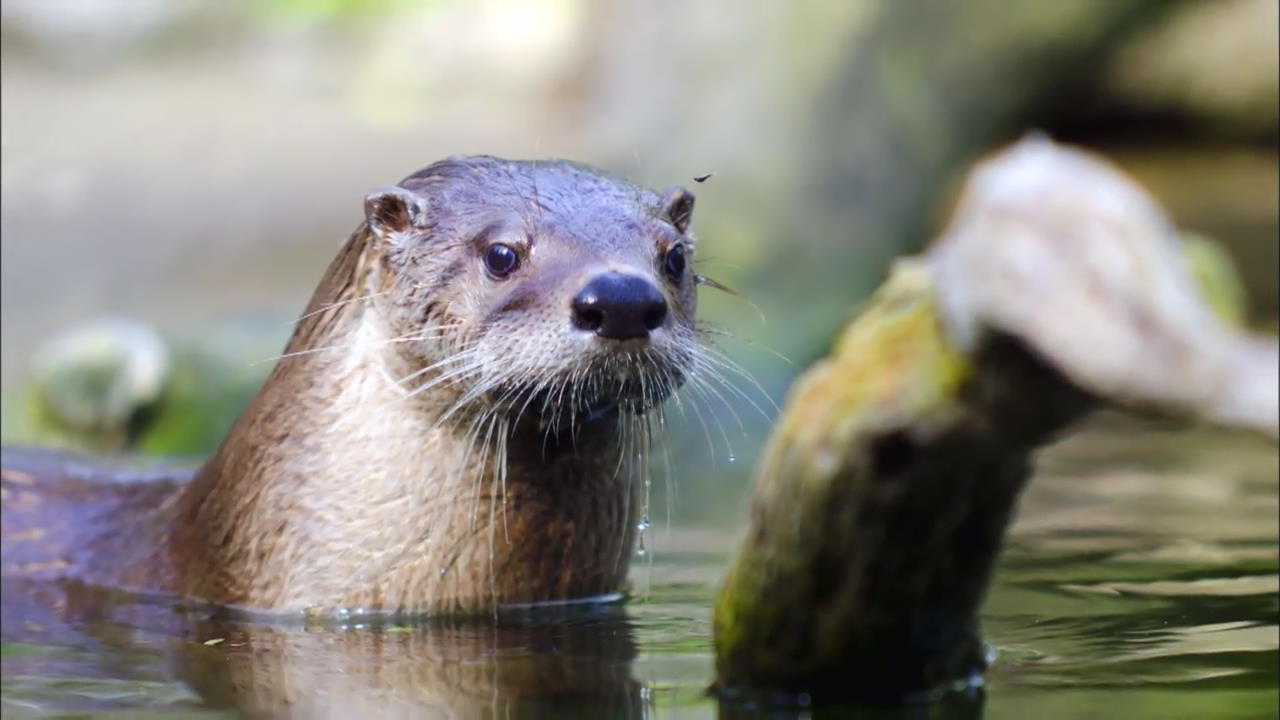Endangered Animals
입력 2017.01.24 (14:14)
수정 2017.01.24 (14:22)
읽어주기 기능은 크롬기반의
브라우저에서만 사용하실 수 있습니다.
[Anchor Lead]
In today’s close up, we have some good news to share about endangered animals that are being discovered across Korea. Of course, it’s only natural that preservation efforts should follow. Here are some scenes of golden bats and otters that are rarely encountered by humans.
[Pkg]
An Orange Whiskered Bat also known as a golden bat has an orange colored body. Their gender ratio is unbalanced and as their numbers in general have significantly dropped due to the destruction of their ecosystem, the bats are protected as level one endangered species. An Orange Whiskered Bat has been found at Gim-nyeong-gul Cave on Jeju Island. The bat was found in hibernation during a regular inspection of caves last month conducted by the Jeju Headquarters of the World Natural Heritage Management Bureau. The same type of bat was found in 2008 at Manjanggul Cave in Jeju which is designated as UNESCO World Heritage. The animal seems to have expanded its habitat. An Orange Whiskered Bat was discovered for the first time in Jeju in 1981 on Hallasan Mountain. Since, spottings have occurred in five locations including the two caves. Only some 200 of the bats are believed to exist in Korea. They are sensitive to the environment and are regarded an indicator of air pollution levels.
[Soundbite] Gi Jin-seok(Curator, Jeju World Heritage Office) : "I believe the bat's discovery in Manjanggul Cave and now also in Gimnyeonggul Cave is the result of preservation efforts including the control of human access."
Now that their habitats are being found across Jeju's natural heritage sites, this all the more calls for the need to better preserve the environment. Otters were once a very common creature found in Korean streams but now, with their numbers drastically fewer, they are designated a natural monument as well asa level-one endangered species. In recent days, otters have been found near the Hangang River for the first time in some 40 years. An otter family of four has been spotted.
[Soundbite] "The excrement shows scales and bones of fish. Here you can see they have eaten ducks."
Since KBS reported last year that a single otter was found at the Hangang River in March, environment authorities installed ten security cameras in the area and verified the habitation of an otter family. The otter in the KBS report is believed to be one of the baby otters of the family.
[Soundbite] Han Seong-yong(Director, Korean Otter Research Center) : "We believe the baby otter filmed last March is the same otter now found with the mother."
Officials are reviewing various measures to foster a stable environment in the river area for the otter family, the first to return in four decades.
In today’s close up, we have some good news to share about endangered animals that are being discovered across Korea. Of course, it’s only natural that preservation efforts should follow. Here are some scenes of golden bats and otters that are rarely encountered by humans.
[Pkg]
An Orange Whiskered Bat also known as a golden bat has an orange colored body. Their gender ratio is unbalanced and as their numbers in general have significantly dropped due to the destruction of their ecosystem, the bats are protected as level one endangered species. An Orange Whiskered Bat has been found at Gim-nyeong-gul Cave on Jeju Island. The bat was found in hibernation during a regular inspection of caves last month conducted by the Jeju Headquarters of the World Natural Heritage Management Bureau. The same type of bat was found in 2008 at Manjanggul Cave in Jeju which is designated as UNESCO World Heritage. The animal seems to have expanded its habitat. An Orange Whiskered Bat was discovered for the first time in Jeju in 1981 on Hallasan Mountain. Since, spottings have occurred in five locations including the two caves. Only some 200 of the bats are believed to exist in Korea. They are sensitive to the environment and are regarded an indicator of air pollution levels.
[Soundbite] Gi Jin-seok(Curator, Jeju World Heritage Office) : "I believe the bat's discovery in Manjanggul Cave and now also in Gimnyeonggul Cave is the result of preservation efforts including the control of human access."
Now that their habitats are being found across Jeju's natural heritage sites, this all the more calls for the need to better preserve the environment. Otters were once a very common creature found in Korean streams but now, with their numbers drastically fewer, they are designated a natural monument as well asa level-one endangered species. In recent days, otters have been found near the Hangang River for the first time in some 40 years. An otter family of four has been spotted.
[Soundbite] "The excrement shows scales and bones of fish. Here you can see they have eaten ducks."
Since KBS reported last year that a single otter was found at the Hangang River in March, environment authorities installed ten security cameras in the area and verified the habitation of an otter family. The otter in the KBS report is believed to be one of the baby otters of the family.
[Soundbite] Han Seong-yong(Director, Korean Otter Research Center) : "We believe the baby otter filmed last March is the same otter now found with the mother."
Officials are reviewing various measures to foster a stable environment in the river area for the otter family, the first to return in four decades.
■ 제보하기
▷ 카카오톡 : 'KBS제보' 검색, 채널 추가
▷ 전화 : 02-781-1234, 4444
▷ 이메일 : kbs1234@kbs.co.kr
▷ 유튜브, 네이버, 카카오에서도 KBS뉴스를 구독해주세요!
- Endangered Animals
-
- 입력 2017-01-24 14:13:33
- 수정2017-01-24 14:22:47

[Anchor Lead]
In today’s close up, we have some good news to share about endangered animals that are being discovered across Korea. Of course, it’s only natural that preservation efforts should follow. Here are some scenes of golden bats and otters that are rarely encountered by humans.
[Pkg]
An Orange Whiskered Bat also known as a golden bat has an orange colored body. Their gender ratio is unbalanced and as their numbers in general have significantly dropped due to the destruction of their ecosystem, the bats are protected as level one endangered species. An Orange Whiskered Bat has been found at Gim-nyeong-gul Cave on Jeju Island. The bat was found in hibernation during a regular inspection of caves last month conducted by the Jeju Headquarters of the World Natural Heritage Management Bureau. The same type of bat was found in 2008 at Manjanggul Cave in Jeju which is designated as UNESCO World Heritage. The animal seems to have expanded its habitat. An Orange Whiskered Bat was discovered for the first time in Jeju in 1981 on Hallasan Mountain. Since, spottings have occurred in five locations including the two caves. Only some 200 of the bats are believed to exist in Korea. They are sensitive to the environment and are regarded an indicator of air pollution levels.
[Soundbite] Gi Jin-seok(Curator, Jeju World Heritage Office) : "I believe the bat's discovery in Manjanggul Cave and now also in Gimnyeonggul Cave is the result of preservation efforts including the control of human access."
Now that their habitats are being found across Jeju's natural heritage sites, this all the more calls for the need to better preserve the environment. Otters were once a very common creature found in Korean streams but now, with their numbers drastically fewer, they are designated a natural monument as well asa level-one endangered species. In recent days, otters have been found near the Hangang River for the first time in some 40 years. An otter family of four has been spotted.
[Soundbite] "The excrement shows scales and bones of fish. Here you can see they have eaten ducks."
Since KBS reported last year that a single otter was found at the Hangang River in March, environment authorities installed ten security cameras in the area and verified the habitation of an otter family. The otter in the KBS report is believed to be one of the baby otters of the family.
[Soundbite] Han Seong-yong(Director, Korean Otter Research Center) : "We believe the baby otter filmed last March is the same otter now found with the mother."
Officials are reviewing various measures to foster a stable environment in the river area for the otter family, the first to return in four decades.
In today’s close up, we have some good news to share about endangered animals that are being discovered across Korea. Of course, it’s only natural that preservation efforts should follow. Here are some scenes of golden bats and otters that are rarely encountered by humans.
[Pkg]
An Orange Whiskered Bat also known as a golden bat has an orange colored body. Their gender ratio is unbalanced and as their numbers in general have significantly dropped due to the destruction of their ecosystem, the bats are protected as level one endangered species. An Orange Whiskered Bat has been found at Gim-nyeong-gul Cave on Jeju Island. The bat was found in hibernation during a regular inspection of caves last month conducted by the Jeju Headquarters of the World Natural Heritage Management Bureau. The same type of bat was found in 2008 at Manjanggul Cave in Jeju which is designated as UNESCO World Heritage. The animal seems to have expanded its habitat. An Orange Whiskered Bat was discovered for the first time in Jeju in 1981 on Hallasan Mountain. Since, spottings have occurred in five locations including the two caves. Only some 200 of the bats are believed to exist in Korea. They are sensitive to the environment and are regarded an indicator of air pollution levels.
[Soundbite] Gi Jin-seok(Curator, Jeju World Heritage Office) : "I believe the bat's discovery in Manjanggul Cave and now also in Gimnyeonggul Cave is the result of preservation efforts including the control of human access."
Now that their habitats are being found across Jeju's natural heritage sites, this all the more calls for the need to better preserve the environment. Otters were once a very common creature found in Korean streams but now, with their numbers drastically fewer, they are designated a natural monument as well asa level-one endangered species. In recent days, otters have been found near the Hangang River for the first time in some 40 years. An otter family of four has been spotted.
[Soundbite] "The excrement shows scales and bones of fish. Here you can see they have eaten ducks."
Since KBS reported last year that a single otter was found at the Hangang River in March, environment authorities installed ten security cameras in the area and verified the habitation of an otter family. The otter in the KBS report is believed to be one of the baby otters of the family.
[Soundbite] Han Seong-yong(Director, Korean Otter Research Center) : "We believe the baby otter filmed last March is the same otter now found with the mother."
Officials are reviewing various measures to foster a stable environment in the river area for the otter family, the first to return in four decades.
이 기사가 좋으셨다면
-
좋아요
0
-
응원해요
0
-
후속 원해요
0

















이 기사에 대한 의견을 남겨주세요.